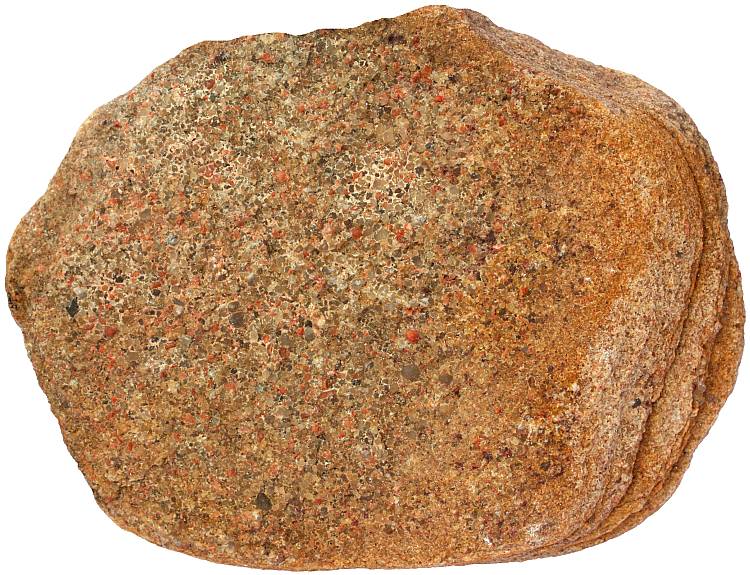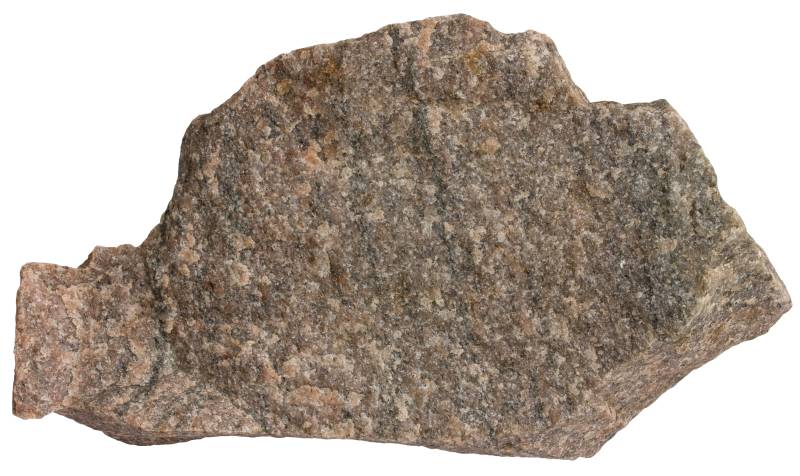Arkose is a feldspar-rich sandstone. It is commonly coarse-grained and usually either pink or gray (depending on the color of feldspar).

Arkose is a type of sandstone that contains lots of feldspar grains. A sample from the precambrian of Finland found on the northwestern coast of Estonia where it was left by the receding Scandinavian continental glacier some 12,000 years ago. Width of sample 15 cm.
Definition
Quartz is usually the dominant mineral in arkose, but feldspar makes up a significant part of the rock (in some cases feldspar may exceed quartz in content). There is no universal agreement, but often 25% of feldspar is set as a requisite for calling sandstone an arkose1.
This is actually more complicated because graywacke (muddy sandstone) may also contain more than 25% feldspar. However, it is not an arkose for the majority of geologists. In most cases, sandstone that is called an arkose, is coarse-grained enough that feldspar grains (which are usually rather angular) can be easily seen with the unaided eye. That has lead to a field description according to which any sandstone that contains appreciable amounts of feldspar in named an arkose. Feldspar is usually pink in color and is therefore easily seen. Such rocks may contain much less than 25% feldspar.
There is no natural discontinuity in the abundance of feldspar in sandstones, but 25% is probably chosen because sandstones that contain that much feldspar are quite distinctive. Sometimes rocks that contain appreciable amount of feldspar, but clearly less than 25% (10…20) are named subarkose. Arkosic sandstones generally contain small amounts of matrix (small dust grains filling the pore space between larger sand grains). Hence, common arkose is an arenite (“clean” sandstone). If arkose is “dirty” (contains more than 15% of muddy component), it is named feldspathic (gray)wacke or arkosic wacke. Arkose has also been defined as a sandstone that contains more than 25% labile constituents of which feldspar forms more than half. According to this definition, arkose might contain as little as 12.5% feldspar2.
Arkose may be associated with reddish sandstones (redbeds), but they should not be confused. Most redbeds are not rich in feldspar. It is a mineral hematite that covers sand grains as a fine pigment and gives a reddish color to redbeds. Some volcanic sands (pyroclastic sediments) may resemble it because they frequently contain reddish fragments (volcanic glass, weathered scoria, fragments of tuff).
http://picasaweb.google.com/107509377372007544953/Sandstone#5787980547557069570
Torridonian sandstone (below) is a precambrian arkose from Scotland.

Metamorphosed arkose or feldspar-rich quartzite. Aust-Agder, Norway. Width of sample 19 cm.
http://picasaweb.google.com/107509377372007544953/2015#6197322360557740066
Heavily metamorphosed and recrystallized arkose. Green mineral is epidote. Salhus, the Bergen Arcs, Norway. Width of view 20 cm.
Composition and texture
Quartz and K-feldspar (usually microcline) are the most important minerals in arkose. Plagioclase is clearly less important than K-feldspar and only in rare cases is plagioclase the dominant feldspar in this rock type.
Why is this the case? Probably because arkosic rocks mostly tend to occur in tectonic settings (continental rifts) which favor the emplacement of K-rich granites instead of Na- and Ca-rich granodiorites and tonalites. Plagioclase feldspar is also clearly less resistant to weathering than K-feldspar, so its chances to survive as a sand grain are not that good. Swauk arkose in Washington State (USA) is an example of arkose sandstone where plagioclase is the dominant feldspar. It is presumably derived from a quartz dioritic source2.
Other notable minerals are micas, amphiboles, rock fragments, clay minerals, heavy minerals, etc. Micas (both biotite, muscovite and also chloritized biotite) tend to be larger than other grains and lie parallel to the bedding. Clay minerals (mostly kaolinite) presumably come from the weathering of K-feldspar. This rock may contain amphiboles if the source material (granite) contained it, but generally mafic minerals are either absent or make up only a small part of the rock. Conglomeratic zones within arkose sequence is a pretty common phenomena. Sand grains making up arkose are usually either angular or poorly rounded. This indicates that in the majority of cases the transportation route has not been very long although there are exceptions. It is not correct to say that arkose is always deposited near its source area. The Mississippi sands near Cairo (Illinois, USA) contain about 25% feldspar but the source area is 1700 km upstream. Ripple marks are not very common in arkose and bedding features are generally thick and not very well-developed, although some units may show strong cross-bedding2.
Occurrence and origin
It is not a rare type of sandstone (it forms up to 15% of all sandstones), but it needs special conditions to form and is therefore not very widespread. The defining property (large feldspar content) needs a good explanation because feldspar (although more common than quartz in the rocks) is much less resistant to weathering and is therefore usually destroyed (converted to clay) even before the quartz grains are liberated from the feldspar-rich rocks.
Hence, it was long believed that arkosic sandstones form in climatic regions which do not support weathering because they are either too dry or too cold. It definitely is the case in some instances because chemical weathering (which is the most important form of weathering) is heavily dependant on the availability of water and to a lesser extent warm temperature which accelerates chemical reactions. However, it is obvious that many arkose formations had no such conditions during their formation. Nowadays it is believed that arkose forms where there is a crystalline source material rich in feldspar (mostly granite or gneiss) and a high relief with a consequent rapid erosion which gives no time to break up feldspar. This is the case with granitic batholiths which are surrounded by down-faulted blocks (grabens) which collect the eroded clastic detritus rich in feldspar. So it seems that relief plays much more important role in the formation process than adverse climatic conditions do. Some older precambrian samples may resemble granite (because of secondary overgrowths of quartz and feldspar) so much that it might be difficult to tell them apart2.
In some cases arkosic sand may be the product of in situ weathering of granite. Such a loose material is known as grus and it may cover granite plutons as a thin weathered veneer of sediments which does not need high relief to form. These granite washes are mostly marine (requires transgression over the granitic terrain) and therefore form a genetically distinct type of arkose because the majority of such sandstones are clearly subaerial. Grus is generally composed of more angular feldspar and the content of feldspar is also usually higher than it is in transported arkose2.
Etymology
The term “arkose” was first used by a French geologist Alexandre Brongniart in 1826 who applied this term to some feldspathic sandstones in the Auvergne region of France2.
http://picasaweb.google.com/107509377372007544953/Sand#5787716056121113634
A feldspar-rich sand sample from Saint Pierre and Miquelon (French island near the coast of Newfoundland). It could become arkose after lithification. The width of the view is 10 mm.
References
1. Siever, R. (2007). Arkose. In: McGraw Hill Encyclopedia of Science & Technology. 10th Edition. McGraw-Hill. Volume 2. 190-191.
2. Pettijohn, F. J., Potter, P. E. & Siever, R. (1973). Sand and Sandstone. Springer.
Leave a Reply